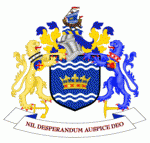City of Sunderland (Sunderland)
 |
The district was formed in 1974 as part of the provisions of the Local Government Act 1972 and is an amalgamation of four former local government districts of County Durham. It was granted city status in 1992, the Ruby Jubilee of Queen Elizabeth II's accession to the throne. The borough had a population of 275,400 at the time of the 2011 census, with the majority of the population (174,286) residing in Sunderland.
The metropolitan borough was formed in 1974 under the Local Government Act 1972 by the merger of several districts of County Durham – Washington Urban District, Houghton-le-Spring Urban District and Hetton Urban District – with the County Borough of Sunderland. The borough was granted city status on 20 May 1992 to celebrate the Queen's Ruby Jubilee. At the Queen's Golden Jubilee the city petitioned to be allowed a Lord Mayor, but was unsuccessful. Although the city does not have a Cathedral, as it is located in the Diocese of Durham, it does have Sunderland Minster.
Between 1939 and 1945 the Wear yards launched 245 merchant ships totalling 1.5 million tons, a quarter of the merchant tonnage produced in the UK at this period. Competition from overseas caused a downturn in demand for Sunderland built ships toward the end of the 20th century. The last shipyard in Sunderland closed in 1988.
St Benedict Biscop was adopted as the city's Patron Saint in March 2004.
Map - City of Sunderland (Sunderland)
Map
Country - United_Kingdom
 |
 |
| Flag of the United Kingdom | |
The United Kingdom has evolved from a series of annexations, unions and separations of constituent countries over several hundred years. The Treaty of Union between the Kingdom of England (which included Wales, annexed in 1542) and the Kingdom of Scotland in 1707 formed the Kingdom of Great Britain. Its union in 1801 with the Kingdom of Ireland created the United Kingdom of Great Britain and Ireland. Most of Ireland seceded from the UK in 1922, leaving the present United Kingdom of Great Britain and Northern Ireland, which formally adopted that name in 1927. The nearby Isle of Man, Guernsey and Jersey are not part of the UK, being Crown Dependencies with the British Government responsible for defence and international representation. There are also 14 British Overseas Territories, the last remnants of the British Empire which, at its height in the 1920s, encompassed almost a quarter of the world's landmass and a third of the world's population, and was the largest empire in history. British influence can be observed in the language, culture and the legal and political systems of many of its former colonies.
Currency / Language
| ISO | Currency | Symbol | Significant figures |
|---|---|---|---|
| GBP | Pound sterling | £ | 2 |
| ISO | Language |
|---|---|
| EN | English language |
| GD | Gaelic language |
| CY | Welsh language |















